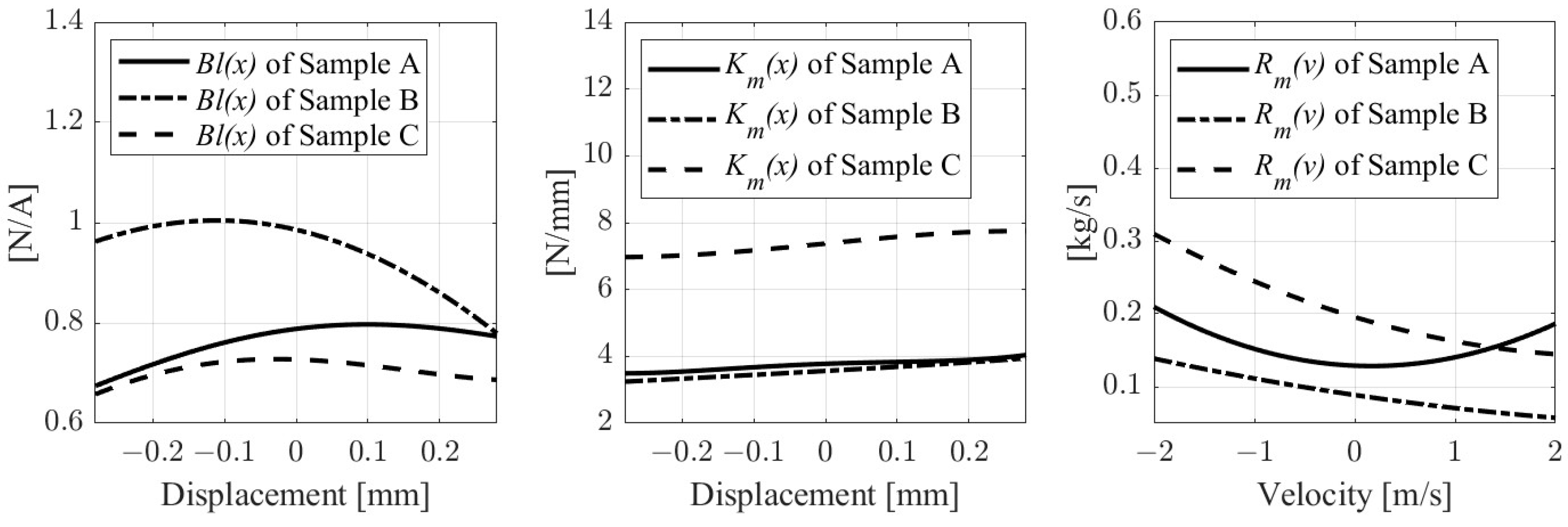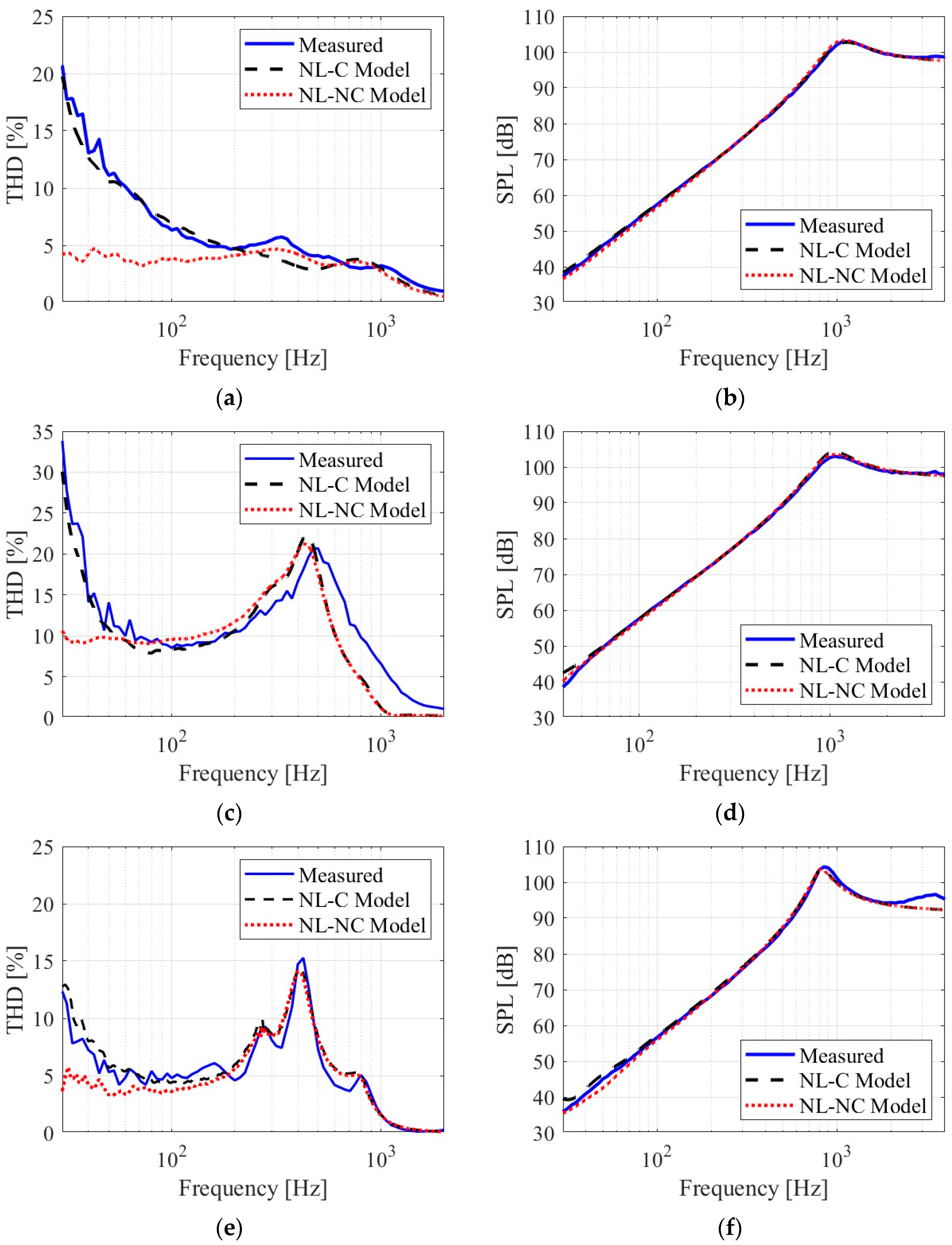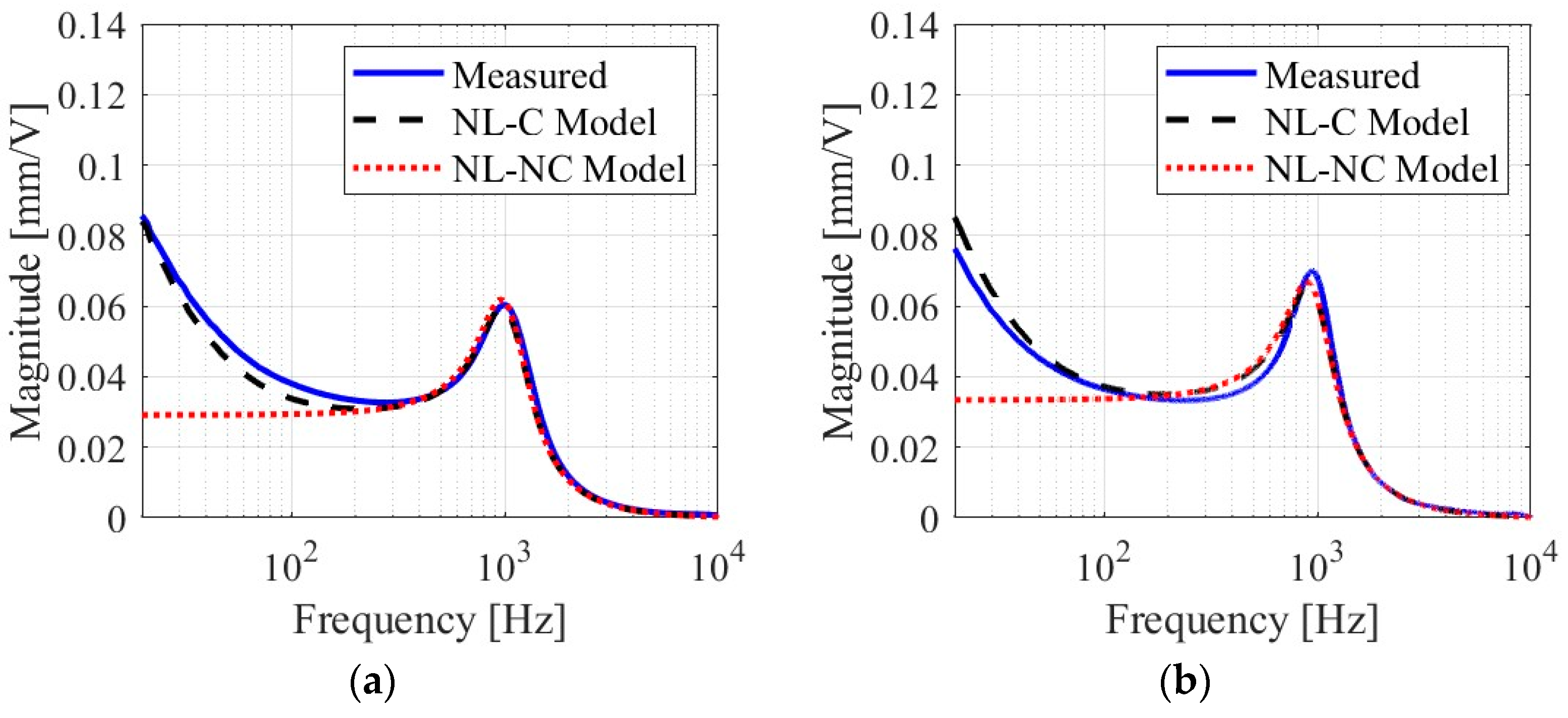Analyzing the Nonlinear Performance of Miniature Loudspeakers in Consideration of the Creep Effect
Abstract
:1. Introduction
2. Nonlinear Model with Creep
2.1. Equivalent Circuit Model
2.2. State–Space Method
2.3. Performance Prediction
3. Experimental Validation
3.1. Experimental Setup
3.2. Results and Discussion
4. Conclusions
Author Contributions
Funding
Institutional Review Board Statement
Informed Consent Statement
Data Availability Statement
Conflicts of Interest
References
- Frank, W.; Reger, R.; Appel, U. Loudspeaker nonlinearities-analysis and compensation. In Proceedings of the Twenty-Sixth Asilomar Conference on Signals, Systems & Computers, Pacific Grove, CA, USA, 26–28 October 1992. [Google Scholar]
- Klippel, W. Adaptive nonlinear control of loudspeaker systems. J. Audio Eng. Soc. 1998, 46, 939–954. [Google Scholar]
- Quaegebeur, N.; Chaigne, A. Nonlinear vibrations of loudspeaker-like structures. J. Sound Vib. 2008, 309, 178–196. [Google Scholar] [CrossRef]
- Merit, B.; Lemarquand, V.; Lemarquand, G.; Dobrucki, A. Motor nonlinearities in electrodynamic loudspeakers: Modelling and measurement. Arch. Acoust. 2009, 34, 579–590. [Google Scholar]
- Klippel, W. Nonlinear large-signal behavior of electrodynamic loudspeakers at low frequencies. J. Audio Eng. Soc. 1992, 40, 483–496. [Google Scholar]
- Klippel, W. Tutorial: Loudspeaker nonlinearities—Causes, parameters, symptoms. J. Audio Eng. Soc. 2006, 54, 907–939. [Google Scholar]
- Dobrucki, A. Nontypical effects in an electrodynamic loudspeaker with a nonhomogeneous magnetic field in the air gap and nonlinear suspensions. J. Audio Eng. Soc. 1994, 42, 565–576. [Google Scholar]
- Bai, M.R.; Huang, C.M. Expert diagnostic system for moving-coil loudspeakers using nonlinear modeling. J. Acoust. Soc. Am. 2009, 125, 819–830. [Google Scholar] [CrossRef] [PubMed]
- Roylance, D. Engineering Viscoelasticity; Department of Materials Science and Engineering, Massachusetts Institute of Technology: Cambridge, MA, USA, 2001; Volume 2139, pp. 1–37. [Google Scholar]
- Knudsen, M.H.; Hansen, P.; Jensen, J.G. The significance of viscoelastic effects in loudspeakers parameter measurements. In Proceedings of the 88th Convention of the Audio Engineering Society, New York, NY, USA, 13–16 March 1990. [Google Scholar]
- Knudsen, M.H.; Jensen, J.G. Low-frequency loudspeaker models that include suspension creep. J. Audio Eng. Soc. 1993, 41, 3–18. [Google Scholar]
- Seidel, U. Fast and accurate measurement of the linear transducer parameters. In Proceedings of the 110th Convention of the Audio Engineering Society, New York, NY, USA, 12–15 May 2001. [Google Scholar]
- Agerkvist, F.T.; Ritter, T. Modeling viscoelasticity of loudspeaker suspensions using retardation spectra. In Proceedings of the 129th Convention of the Audio Engineering Society, New York, NY, USA, 4–7 November 2010. [Google Scholar]
- Hiebel, H. Suspension creep models for miniature loudspeakers. In Proceedings of the 132nd Convention of the Audio Engineering Society, Budapest, Hungary, 26–29 April 2012. [Google Scholar]
- Findley, W.N.; Davis, F.A. Creep and Relaxation of Nonlinear Viscoelastic Materials; Courier Corporation: North Chelmsford, MA, USA, 2013; pp. 52–58. [Google Scholar]
- Agerkvist, F.; Thorborg, K.; Tinggard, C. A study of the creep effect in loudspeaker suspension. In Proceedings of the 125th Convention of the Audio Engineering Society, San Francisco, CA, USA, 2–5 October 2008. [Google Scholar]
- Petošić, A.; Đurek, I.; Đurek, D. Modeling of an electrodynamic loudspeaker including membrane viscoelasticy. In Proceedings of the 124th Convention of the Audio Engineering Society, New York, NY, USA, 17–20 May 2008. [Google Scholar]
- Thorborg, K.; Tinggaard, C.; Agerkvist, F.; Futtrup, C. Frequency dependence of damping and compliance in loudspeaker suspensions. J. Audio Eng. Soc. 2010, 58, 472–486. [Google Scholar]
- Falaize, A.; Hélie, T. Passive modelling of the electrodynamic loudspeaker: From the Thiele–Small model to nonlinear port-Hamiltonian systems. Acta Acust. 2020, 4, 1. [Google Scholar] [CrossRef]
- Brosch, R. Loudspeaker Simulation considering Suspension Creep. Master’s Thesis, Institute of Signal Processing and Speech Communication, Graz University of Technology, Graz, Austria, 2020. [Google Scholar]
- King, A.; Agerkvist, F. Fractional derivative loudspeaker models for nonlinear suspensions and voice coils. J. Audio Eng. Soc. 2018, 66, 525–536. [Google Scholar] [CrossRef]
- Tian, X.; Shen, Y.; Chen, L.; Zhang, Z. Identification of nonlinear fractional derivative loudspeaker model. J. Audio Eng. Soc. 2020, 68, 355–363. [Google Scholar] [CrossRef]







| Linear Parameters | Re | Le | Mm | K2 | R2 |
|---|---|---|---|---|---|
| [unit] | [Ohm] | [mH] | [g] | [N/mm] | [kg/s] |
| Sample A | 5.74 | 0.041 | 0.128 | 1.005 | 16.5 |
| Sample B | 6.96 | 0.050 | 0.121 | 1.103 | 15.0 |
| Sample C | 3.72 | 0.045 | 0.314 | 1.063 | 26.0 |
| Sample A | Sample B | Sample C | |||||
|---|---|---|---|---|---|---|---|
| NL-NC Model | NL-C Model | NL-NC Model | NL-C Model | NL-NC Model | NL-C Model | ||
| Clip 01 | Total | 0.0321 | 0.0086 | 0.0216 | 0. 0091 | 0.0251 | 0.0047 |
| <500 Hz | 0.0320 | 0.0083 | 0.0215 | 0.0088 | 0.0248 | 0.0034 | |
| >500 Hz | 0.0031 | 0.0024 | 0.0024 | 0.0022 | 0.0035 | 0.0032 | |
| Clip 02 | Total | 0.0343 | 0.0107 | 0.0238 | 0.0102 | 0.0270 | 0.0067 |
| <500 Hz | 0.0341 | 0.0104 | 0.0236 | 0.0099 | 0.0267 | 0.0059 | |
| >500 Hz | 0.0029 | 0.0026 | 0.0029 | 0.0025 | 0.0034 | 0.0032 | |
Disclaimer/Publisher’s Note: The statements, opinions and data contained in all publications are solely those of the individual author(s) and contributor(s) and not of MDPI and/or the editor(s). MDPI and/or the editor(s) disclaim responsibility for any injury to people or property resulting from any ideas, methods, instructions or products referred to in the content. |
© 2024 by the authors. Licensee MDPI, Basel, Switzerland. This article is an open access article distributed under the terms and conditions of the Creative Commons Attribution (CC BY) license (https://creativecommons.org/licenses/by/4.0/).
Share and Cite
Chen, S.; Huang, J.; Su, F.; Feng, X.; Shen, Y. Analyzing the Nonlinear Performance of Miniature Loudspeakers in Consideration of the Creep Effect. Appl. Sci. 2024, 14, 5681. https://doi.org/10.3390/app14135681
Chen S, Huang J, Su F, Feng X, Shen Y. Analyzing the Nonlinear Performance of Miniature Loudspeakers in Consideration of the Creep Effect. Applied Sciences. 2024; 14(13):5681. https://doi.org/10.3390/app14135681
Chicago/Turabian StyleChen, Simiao, Jie Huang, Fenshan Su, Xuelei Feng, and Yong Shen. 2024. "Analyzing the Nonlinear Performance of Miniature Loudspeakers in Consideration of the Creep Effect" Applied Sciences 14, no. 13: 5681. https://doi.org/10.3390/app14135681






